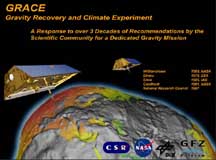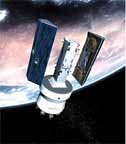
|
GRACE Publications |
 The GRACE Satellites - One Year on Orbit
The GRACE Satellites - One Year on OrbitMarch 17, 2003 One year ago today at 09:21 UTC, the twin GRACE satellites were lofted into orbit aboard a Rockot launch vehicle from Russia. The GRACE launch was a major step in addressing a four-decade quest for high accuracy, high resolution, and global homogeneous gravity data. During the past year, the satellites have undergone an extensive set of on orbit tests to demonstrate the inter-satellite ranging capability. Along with the extended on-orbit activities, the satellites have gathered over 100 days of science level data. The satellites and instruments are performing remarkably well, given the ambitious goals. They are utilizing cutting edge technology to develop micron-level ranging accuracy and high-precision accelerometer measurements. These measurements involve all elements of the dual satellite configuration. The satellite operations center is also performing well with over a 95% collection rate of data. In December of 2002 the GRACE team released its first image that graphically illustrated its sensitivity to changes in the Earth's gravity and confirming the satellites measurement sensitivity. As a part of the instrument and system accuracy assessment, a data set of 111 days has been used to determine a preliminary GRACE gravity model. This initial model shows a significant improvement over previous models for wavelengths of 500 to 15,000 km and, in this region, it has exceeded, by a factor of 10 to 50, the accuracy achieved using the of gravity measurements collected over the past 30 years. The mission is well on its way to satisfying minimum mission requirements and to surpassing it in some respects. The initial GRACE gravity model has been able to provide remarkable resolution of geophysical features observed directly from space. This model has reduced errors in the geoid model to the centimeter level to wavelengths as short as 500 km. The initial GRACE gravity model has already been shown to enable a dramatic improvement in the altimetric determination of ocean currents.
Download the PDF. |


 The Grace Mission is a joint partnership between NASA and the German Aerospace Center (Deutsches Zentrum fuer Luft und Raumfahrt, or DLR). The University of Texas' Center for Space Research has overall mission responsibility. GeoForschungsZentrum Potsdam is responsible for the German mission elements. JPL manages the U.S. portion of the project for NASA's Office of Earth Science, Washington, D.C. Science data processing, distribution, archiving and product verification are managed under a cooperative arrangement between the University of Texas' Center for Space Research , the Jet Propulsion Laboratory and the GeoForschungsZentrum, Potsdam.
The Grace Mission is a joint partnership between NASA and the German Aerospace Center (Deutsches Zentrum fuer Luft und Raumfahrt, or DLR). The University of Texas' Center for Space Research has overall mission responsibility. GeoForschungsZentrum Potsdam is responsible for the German mission elements. JPL manages the U.S. portion of the project for NASA's Office of Earth Science, Washington, D.C. Science data processing, distribution, archiving and product verification are managed under a cooperative arrangement between the University of Texas' Center for Space Research , the Jet Propulsion Laboratory and the GeoForschungsZentrum, Potsdam.